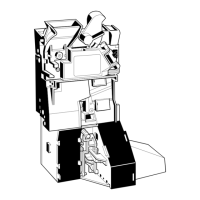Warning:- If directing more than one coin to the same exit
route then use diodes on the routing plug.
Route Inhibit Connector
The function of the route Inhibit Connector is to signal when
specific exits, external to the product, are in a “Full”
condition. Signals from the machine ensure that, while the
“Full” condition continues, further coins/tokens directed to
that exit will be re-routed to an alternative exit. The
instruction as to which alternative exits can be used will
normally come from the routing plug. In order to inhibit a
particular route, 0V must be applied to its respective pin. An
alternative route must always be of a lower priority.
Ground0 Volts0 Volts9
Exit A is DefaultExit 8 is Default8
BDivert Route 77
DDivert Route 66
CDivert Route 55
(b)Divert Route 44
(a)Divert Route 33
(c)Divert Route 22
(d)Divert Route 11
EXIT
Priorities
126129
Pin
Number
Route Inhibit Connector Detail
N.B. Clear exits are Separator only
Shaded exits are Manifold only
Separator Outline Manifold Outline
8 7 6
5
4
3
2
1
1
2
3
4
5
6
7
8
Reject
Viewed from above
8 Way Separator Exits
21
19
17
15
13
11
9
7
5
3
Coin A
Coin C
Coin E
Coin G
Pin
1Route 7 (B)
Route 6 (D)
Route 5 (C)
Route 1 (d)
Route 2 (c)
Route 3 (a)
Route 4 (b)
Pin
22
20
18
16
14
12
10
8
6
4
2
Coin B
Coin D
Coin F
Coin H
Route 7 (B)
Route 6 (D)
Route 5 (C)
Route 1 (d)
Route 2 (c)
Route 3 (a)
Route 4 (b)
Routing Plug Viewed From Wire Links End
Example 3
Routes coin E to route 1 then overflows it to route 2.
The CashFlow
®
126/129 validation system offers two
routing priority orders. These can be activated by the
use of links fitted to a routing plug.
If you use the upper case letter the overflow order is C,
D, B and A ( A = default exit route).
If the lowercase letter is used the overflow order is d, c,
a, and b.
Example:-
If coin ‘F’ is set to route to exit ‘C ‘ ( first exit) and when
tube ‘C’ is full (i.e. inhibit applied to tube C) will route to
exit ‘D’ (second exit), wire the route plug using wire
links as follows:-
pin 20 to 6 = coin ‘F’ to exit ‘C’ (first exit)
pin 5 to 3 = coin ‘F’ to exit ‘D’ (overflow/second
exit)
C
BA
D
(d) (c)
(a) (b)
Viewed from above
4 Way Separator Exits
Lowercase = Higher Priority Route.
Uppercase = Lower Priority Route.
Routing Plug Viewed From Wire Links End
21
19
17
15
13
11
9
7
5
3
Exit B
Exit D
Exit C
Coin A
Coin C
Coin E
Coin G
Pin
Pin
1
22
20
18
16
14
12
10
8
6
4
2
Exit B
Exit D
Coin B
Coin D
Coin F
Coin H
Exit C
( exit 'd' )
( exit 'c' )
( exit 'a' )
( exit 'b' )
( exit 'd' )
( exit 'c' )
( exit 'a' )
( exit 'b' )
Example 1
Routes £1 (coin output F) to exit D,
then £1 overflows to exit C.
This routing plug is wired using standard
wire links.
Routing Plug Viewed From Diode Links End
Example 2
21
19
17
15
13
11
9
7
5
3
Exit B
Exit D
Exit C
Coin A
Coin C
Coin E
Coin G
Pin
Pin
1
22
20
18
16
14
12
10
8
6
4
2
Exit B
Exit D
Coin B
Coin D
Coin F
Coin H
Exit C
( exit 'd' )
( exit 'c' )
( exit 'a' )
( exit 'b' )
( exit 'd' )
( exit 'c' )
( exit 'a' )
( exit 'b' )
Routes 20p & £1 (coin outputs D & F)
to exit C.
This routing plug is wired using diode links.
Mars Electronics International,
Eskdale Road,
Winnersh Triangle, Wokingham,
Berkshire, RG41 5AQ
Internet:http://www.meiglobal.com
Quick Reference Guide
Applies to Product Version G1
Coin
Enabled
Coin
Output
Coin
Type
Channel
Affected
25012 G1 ©, Mars, Inc., 1997 707403044

